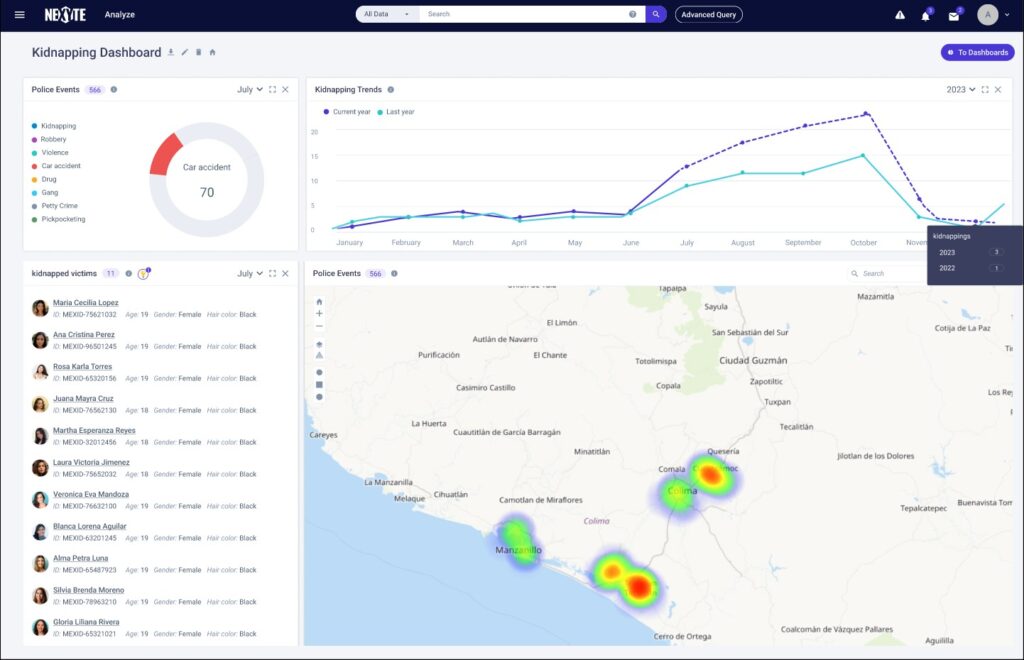Intelligence Analysis Software for Police Forces: Revolutionizing Crime-Fighting in the Digital Era

In today’s complex crime landscape, intelligence analysis software is essential for police forces to effectively combat crime. Discover how your organization can leverage this technology.
Intelligence Challenges for Police Forces
As technology and globalization continue to advance at breakneck speed, crime is becoming more sophisticated than ever. Cross-border crime is growing rapidly, as it is easier than ever to communicate, transfer money, and travel between countries. In addition criminals are widening their scope and no longer focusing on one type of crime. In fact, over 40% of organized crime groups in Europe are reported to be involved in more than one criminal activity. Criminals are taking advantage of technological advancements, such as drones, cryptocurrency, and AI to stay one step ahead of law enforcement. And cybercrime is on the rise, with the FBI’s Internet Crime Complaint Center (IC3) receiving a record 791,790 complaints, and reporting losses exceeding $4.2 billion, in one year.
Traditional investigation and intelligence methodologies and tools are no longer sufficient to keep up with the staggering volumes of data and the increasing complexity of modern crime. Authorities require a sophisticated solution capable of extracting actionable insights from the overwhelming flood of information. This is where intelligence analysis software comes in.
What is Intelligence Analysis Software for Police Forces?
Intelligence analysis software is a suite of tools designed to help law enforcement agencies extract, process, analyze, and visualize data to generate actionable intelligence. These tools use AI-powered analytics to identify patterns, trends and connections that would be difficult, if not impossible, for investigators to discover manually. This process supports investigators in deriving actionable intelligence insights that can reveal how suspects or groups are connected, uncover the modus operandi of criminals and crime networks, map the movement of money, expose sources of illegal weapons, and more. Essentially, intelligence analysis software transforms raw data into insights that can aid in solving crimes.
Benefits of Using Intelligence Analysis Software in Police Work
Implementing intelligence analysis software in police work offers numerous benefits:
- Enhanced data processing: Automates the ingestion and analysis of large volumes of data, reducing the time and effort required to process information manually.
- Improved accuracy: Leverages tailored algorithms to identify patterns and connections with high precision, minimizing human error.
- Proactive crime prevention: Harnesses predictive analytics to identify trends in criminal activity, empowering police to take a proactive approach to investigations.
- Faster case resolution: Automates processes and analytics, enabling investigators to focus on complex decision-making that cannot be done by machines and technology alone.
- Comprehensive case management: Integrates data from multiple sources, providing a holistic view of cases and investigations.
Core Capabilities of Intelligence Analysis Software
Intelligence analysis software encompasses a variety of capabilities that can significantly enhance police work. Some core capabilities include:
1. Data integration and fusion: Combines data from disparate sources, such as social media, financial records, and security camera footage, into a unified platform. For example, police can use this capability to analyze the activities and connections of a suspect across different channels.
2. Link analysis: Automatically identifies relationships and connections between entities (people, places, events, etc.) within investigation data. This is crucial in complicated cases, for example, helping investigators to uncover criminal networks and understand their structure.

Link analysis diagram
3. Geospatial analysis: Analyzes geographic data related to investigations, enabling investigators to quickly uncover patterns that would be difficult or impossible to access without geospatial analysis. This helps in deploying patrols more effectively and in deploying operations efficiently in high-risk areas.

Geospatial analysis display showing gun trafficking trends
4. Analysis of unstructured data: Sifts through vast amounts of unstructured data, including text, audio, images and video, including digital forensics data from confiscated suspect devices, and automatically derives actionable insights.
5. Predictive analytics: Uses historical data to support a proactive approach to investigations. This allows police to take preventive measures to deter criminal activity.
6. AI-powered analytics: Provides extensive analysis at scale by automating the data exploration process, uncovering previously unknow insights from unstructured data, prioritizing police officers’ workloads, helping find ways to expand investigations, and aiding in data-driven decision-making.
Intelligence Analysis Software Use Cases
Intelligence analysis software offers significant advantages in various investigative scenarios:
- Organized crime: Data is integrated from various sources to help investigators map out criminal networks, identify key players, and provide actionable intelligence for law enforcement in disrupting crime networks.
- Gun crime: Ballistics data can be integrated to help investigators analyze the movement of firearms and correlate incidents to identify patterns and connections between different crimes. This helps in pinpointing sources of illegal firearms and linking suspects to multiple crime scenes.
- Human trafficking: Various data points can be analyzed, including travel patterns of suspects and victims, as well as financial transactions, to identify trafficking networks and rescue victims.
- Money laundering: Suspicious financial transactions can be pinpointed with the help of investigative analysis software in order to follow the flow of illicit funds, helping authorities dismantle money laundering operations.
- Cryptocurrency fraud: Digital currency transactions, which are often used in organized crime and terrorism funding, can be mapped in order to link anonymous wallets to suspects and uncover illegal activities.
Intelligence Analysis Software vs. Decision Intelligence Platforms
While both intelligence analysis software and decision intelligence platforms are designed to aid in data-driven decision-making, decision intelligence platforms are more comprehensive, and offer more advanced and innovative capabilities.
- Intelligence analysis software: Primarily focused on processing and analyzing crime-related data to generate actionable insights for law enforcement. It emphasizes pattern recognition, predictive analytics, and real-time data processing.
- Decision intelligence platforms: Broader in scope, these platforms offer a holistic investigative solution designed to support decision-making in a wide range of domains and industries, including law enforcement, national intelligence, financial investigations, and more. They integrate data from a wide variety of diverse sources and use advanced analytics to provide hidden insights that aid in strategic decision-making.

Decision intelligence platform: holistic entity profile
A top-tier decision intelligence platform includes a suite of investigative tools, including user-defined queries and alerts, AI-powered data enrichment capabilities, timeline analysis, geospatial analysis, and more.
Conclusion
Intelligence analysis software is essential for modern police forces as they move toward comprehensive decision intelligence solutions. These tools improve the efficiency, accuracy, and effectiveness of law enforcement by addressing data challenges in crime investigations. Key capabilities such as data integration, link analysis, and geospatial and predictive analytics help police stay ahead of criminal activities and make data-driven decisions. As the digital landscape evolves, adopting such software will be vital for maintaining public safety and tackling the complexities of modern crime with precision and foresight.
Click here to learn how your organization can benefit from decision intelligence
The post Intelligence Analysis Software for Police Forces: Revolutionizing Crime-Fighting in the Digital Era appeared first on Cognyte.
Article Link: Intelligence Analysis Software for Police Forces | Cognyte
1 post - 1 participant
Malware Analysis, News and Indicators - Latest topics
